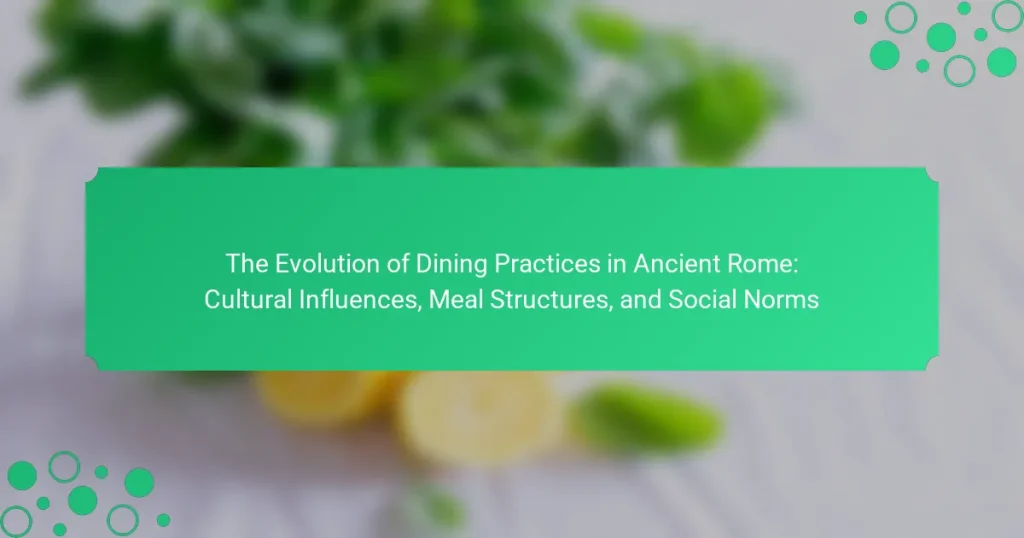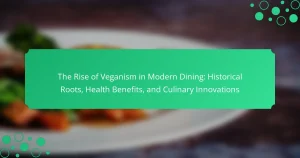The article examines the evolution of dining practices in Ancient Rome, highlighting the cultural influences, meal structures, and social norms that shaped these practices. It details the communal nature of Roman meals, often held in a triclinium, where guests reclined and enjoyed multiple courses featuring diverse foods such as fruits, meats, and wine. The article also discusses how dining practices evolved from simple sustenance during the Republic to elaborate banquets in the Empire, reflecting social status and culinary sophistication. Additionally, it explores the lasting impact of these practices on modern cuisine, including the introduction of multi-course meals and the importance of communal dining.

What are the key characteristics of dining practices in Ancient Rome?
Dining practices in Ancient Rome were characterized by communal eating, elaborate banquets, and diverse food offerings. Meals often took place in a triclinium, a reclining dining space. Guests reclined on couches arranged around a central table. The Romans enjoyed multiple courses, with appetizers, main dishes, and desserts. They consumed a variety of foods, including fruits, vegetables, meats, and fish. Wine was a staple beverage, often mixed with water. Social status influenced dining practices; elite Romans hosted extravagant feasts. These gatherings showcased wealth and culinary skills. Historical texts, such as “Satire” by Juvenal, provide insights into these practices and their cultural significance.
How did cultural influences shape dining practices in Ancient Rome?
Cultural influences significantly shaped dining practices in Ancient Rome. The Romans adopted culinary techniques and ingredients from conquered territories. Greek culture introduced elaborate dining customs, including the symposium, which emphasized social interaction. Additionally, Etruscan influences led to the development of the convivium, a formal banquet setting. The availability of diverse foods from trade expanded the Roman palate. Social status dictated dining practices, with elite classes enjoying lavish feasts. Public dining establishments, such as thermopolia, catered to the lower classes. Religious rituals also influenced meal structures, with offerings made to gods during feasts. Overall, cultural exchanges enriched Roman dining experiences, reflecting their diverse society.
What role did geography play in the evolution of Roman dining?
Geography significantly influenced the evolution of Roman dining. The vast Roman Empire encompassed diverse regions with varying climates and agricultural practices. This diversity allowed for a wide range of food sources, including grains, fruits, and meats. Coastal regions provided seafood, while inland areas contributed livestock and grains. Trade routes facilitated the import of exotic ingredients from distant lands. For example, spices from Asia and olives from the Mediterranean enriched Roman cuisine. Additionally, geography shaped dining customs, with urban centers developing elaborate dining practices compared to rural areas. The availability of resources directly impacted meal structures and social norms related to dining. Thus, geography was a crucial factor in the development of Roman culinary traditions.
How did trade and conquest affect the ingredients used in Roman meals?
Trade and conquest significantly expanded the variety of ingredients used in Roman meals. The Roman Empire’s extensive trade networks facilitated the import of spices, grains, and exotic foods from distant regions. For instance, pepper from India and silphium from North Africa became popular in Roman cuisine. Conquests brought new agricultural practices and crops, such as olives and grapes from the Mediterranean. Furthermore, the incorporation of local ingredients from conquered territories enriched Roman culinary diversity. This blending of flavors and techniques transformed traditional Roman meals into a more varied and sophisticated dining experience. Historical records indicate that these influences contributed to the development of a more complex gastronomy in ancient Rome.
What were the typical meal structures in Ancient Rome?
Ancient Rome typically had three main meals: breakfast, lunch, and dinner. Breakfast, known as ‘ientaculum’, was light and often consisted of bread, cheese, and fruit. Lunch, called ‘prandium’, was also modest, usually featuring leftovers from dinner or simple dishes. Dinner, or ‘cena’, was the primary meal of the day and could be elaborate. It often included multiple courses and a variety of foods such as meats, vegetables, and fruits. The meal structure reflected social status, with wealthier Romans enjoying more elaborate dinners. Historical texts indicate that dining practices evolved with influences from Greek and Etruscan cultures, impacting meal composition and social dining customs.
What were the different types of meals consumed by Romans?
Romans consumed three main types of meals: breakfast (ientaculum), lunch (prandium), and dinner (cena). Ientaculum was often a light meal, typically consisting of bread, cheese, and sometimes fruit. Prandium was a modest meal, often featuring leftovers from cena, along with bread and vegetables. Cena was the main meal, served in the evening, and could be quite elaborate, including multiple courses of meat, fish, vegetables, and wine. Historical texts, such as those by Apicius, detail these meal structures and their cultural significance in Roman society.
How did the timing of meals reflect social status in Ancient Rome?
In Ancient Rome, the timing of meals was a significant indicator of social status. The elite class typically dined later in the day, often enjoying their main meal, the cena, after sunset. This practice allowed them to showcase their wealth and social standing through elaborate feasts. In contrast, the lower classes consumed their meals earlier, often having a simple meal during the day.
The senatorial class and wealthy citizens had access to more leisure time, enabling them to eat later. They could afford to host lengthy meals with multiple courses. Historical texts indicate that the timing of these meals was a reflection of their lifestyle and societal position.
Additionally, the wealthy often used meal timings to display their status to others. They would invite guests to dine at their homes during the late evening, further emphasizing their social rank. The disparity in meal timings clearly illustrated the social hierarchy within Roman society.
What social norms surrounded dining practices in Ancient Rome?
Social norms in Ancient Rome regarding dining practices included a strong emphasis on social hierarchy. The wealthy hosted elaborate banquets, showcasing their status through extravagant food and entertainment. Guests were often reclined on couches, which indicated social ranking. The seating arrangement reflected a person’s importance; the most honored guests sat closest to the host. Meals were communal and often included multiple courses, promoting social interaction. Rituals such as toasting and offering libations were common, reinforcing social bonds. Dining etiquette dictated that guests should not overindulge or engage in quarrels, maintaining decorum. Additionally, the use of specific utensils and serving styles varied based on social class, illustrating the divide between the elite and lower classes.
How did dining etiquette vary among different social classes?
Dining etiquette in Ancient Rome varied significantly among different social classes. The elite practiced formal dining rituals, including reclining on couches and using multiple utensils. They emphasized elaborate meals with multiple courses and fine wines. In contrast, lower classes had simpler dining practices. They often ate while seated on benches or at tables. Their meals typically consisted of basic foods like bread and porridge. The differences in dining etiquette reflected broader social hierarchies. Elite banquets showcased wealth and status, while lower-class meals were practical and communal. This distinction in dining practices highlights the cultural influences and social norms of Ancient Roman society.
What significance did communal dining hold in Roman society?
Communal dining was significant in Roman society as it fostered social bonds and reinforced hierarchy. It served as a platform for political discussions and alliances. Meals were often shared among friends, family, and patrons. This practice emphasized the importance of hospitality and generosity. The Romans believed communal meals strengthened community ties. They also reflected social status, with elaborate feasts showcasing wealth. Additionally, communal dining was a setting for cultural exchange and the dissemination of ideas. Overall, it played a vital role in shaping Roman social structures.

How did dining practices in Ancient Rome evolve over time?
Dining practices in Ancient Rome evolved significantly from the Republic to the Empire. Initially, meals were simple and focused on basic sustenance. As Rome expanded, culinary influences from conquered regions enriched the diet. The introduction of new ingredients and cooking techniques transformed meal preparation. By the late Republic, banquets became popular among the elite, showcasing wealth and status. The structure of meals also changed, with the addition of multiple courses and elaborate presentations. Social customs surrounding dining reflected class distinctions, with separate dining practices for different social strata. The transition to communal dining emphasized social interaction and entertainment. Overall, dining practices became more sophisticated, reflecting Rome’s cultural evolution and social hierarchy.
What were the major influences on the evolution of Roman dining practices?
The major influences on the evolution of Roman dining practices included cultural interactions, social hierarchy, and available resources. Cultural interactions with Greek and Etruscan societies introduced new foods and dining customs. The Roman elite adopted elaborate feasting styles, emphasizing luxury and presentation. Social hierarchy dictated meal structures, with different courses and seating arrangements reflecting status. Available resources, such as local agriculture and trade routes, shaped the variety of ingredients used in meals. The incorporation of spices and exotic foods from conquered territories further diversified Roman cuisine. These influences collectively transformed dining into a social and cultural experience in ancient Rome.
How did political changes impact dining customs in Ancient Rome?
Political changes significantly influenced dining customs in Ancient Rome. The transition from Republic to Empire altered social hierarchies. As emperors rose to power, lavish banquets became symbols of status. The elite hosted extravagant feasts to display wealth and power. This shift led to the inclusion of exotic foods and elaborate recipes. Political alliances were often forged during these communal meals. Additionally, laws regulated food distribution, impacting availability and variety. The political climate shaped dining etiquette and meal structures within society. Overall, political changes redefined the significance and experience of dining in Ancient Rome.
What role did religion play in the evolution of meals and dining rituals?
Religion significantly influenced the evolution of meals and dining rituals in Ancient Rome. Religious beliefs shaped the types of food that were considered acceptable for consumption. Certain foods were dedicated to specific gods, creating a connection between meals and [censured]. Rituals such as sacrifices involved the preparation and sharing of meals, reinforcing community bonds. Festivals often included communal feasting, reflecting the importance of divine favor in agricultural abundance. The practice of offering food to deities before consumption became a common ritual. These religious customs established guidelines for meal preparation and consumption. Overall, religion served as a framework that guided social interactions and dietary practices in Ancient Roman society.
What innovations emerged in Roman dining practices?
Roman dining practices saw several significant innovations. One major innovation was the introduction of the triclinium, a dining arrangement with three couches. This setup allowed diners to recline while eating, which became a symbol of luxury and social status. Another innovation was the use of elaborate serving techniques, including multiple courses and the presentation of food in artistic arrangements. The Romans also popularized the use of sauces and spices to enhance flavors, reflecting their interactions with other cultures. Additionally, the incorporation of utensils, such as knives and spoons, improved the dining experience. These innovations transformed meals into social events, emphasizing hospitality and communal dining.
How did advancements in cooking technology influence meal preparation?
Advancements in cooking technology significantly influenced meal preparation in ancient Rome. Innovations such as the development of the hypocaust system allowed for more effective heating of food. This method provided consistent and controllable cooking temperatures. The introduction of pottery and metal cookware improved food storage and preparation techniques. These materials enabled a wider variety of dishes to be cooked efficiently. Additionally, the use of spices and herbs became more prevalent with improved preservation methods. This expanded the flavor profiles of Roman cuisine. The ability to cook in larger quantities also facilitated social gatherings and communal meals. Overall, these technological advancements transformed how meals were prepared and consumed in Roman society.
What new dining formats were introduced during the Roman Empire?
The Roman Empire introduced several new dining formats, including the triclinium and communal dining. The triclinium was a formal dining room with three couches arranged around a central table. This layout encouraged reclining while eating, which was a departure from previous practices. Communal dining became popular, with multiple guests sharing dishes, fostering social interaction. Additionally, public banquets and feasts became more common, reflecting the empire’s wealth and social structures. These innovations marked a shift in dining culture, emphasizing luxury and social engagement among the elite.

What lasting impacts did Ancient Roman dining practices have on modern cuisine?
Ancient Roman dining practices significantly influenced modern cuisine. They introduced the concept of multi-course meals, which is common today. Romans often served several dishes in succession, a practice that persists in contemporary fine dining. The use of herbs and spices to enhance flavor originated in Roman kitchens. Their emphasis on fresh ingredients laid the groundwork for modern culinary practices. Additionally, the tradition of communal dining can be traced back to Roman banquets. This social aspect of eating continues to be important in many cultures. The Roman approach to food presentation and aesthetics also impacts modern culinary artistry. Overall, Ancient Roman dining practices shaped various elements of today’s culinary landscape.
How do ancient Roman dining practices influence contemporary dining habits?
Ancient Roman dining practices significantly influence contemporary dining habits. The Romans emphasized communal meals, which fostered social interaction. This tradition persists in modern dining, where gatherings often center around shared meals. Additionally, Roman meals were structured into multiple courses, a practice mirrored in today’s fine dining experiences. The use of specific utensils, such as forks and knives, originated in Roman times and remains essential in contemporary settings. Furthermore, the concept of dining as a cultural event, complete with etiquette and rituals, has its roots in Roman customs. These practices showcase the enduring legacy of Roman dining on modern culinary culture.
What elements of Roman cuisine are still present in modern Italian cooking?
Elements of Roman cuisine that are still present in modern Italian cooking include pasta, sauces, and certain cooking techniques. Roman cuisine emphasized the use of fresh ingredients, which remains a cornerstone of Italian cooking today. Dishes like spaghetti alla carbonara and cacio e pepe have their roots in ancient Rome. The tradition of using olive oil as a primary fat for cooking also originates from Roman practices. Additionally, the use of herbs such as oregano and basil is consistent with Roman flavor profiles. Roman-style bread, particularly focaccia, has influenced modern Italian bread-making. Lastly, the communal dining experience, typical in Roman times, is mirrored in contemporary Italian meals. These elements showcase the lasting impact of Roman culinary traditions on modern Italian cuisine.
How have social dining norms from Ancient Rome persisted today?
Social dining norms from Ancient Rome have persisted today through communal eating practices and the importance of hospitality. In Ancient Rome, meals were often shared among family and friends, fostering social bonds. This practice continues in modern cultures where communal dining is valued. Roman dining emphasized the role of the host in providing for guests, a tradition reflected in contemporary hospitality norms. Additionally, the concept of the banquet, where multiple courses are served, remains prevalent in modern dining experiences. The use of specific dining etiquette, such as toasting and table manners, also traces back to Roman customs. These enduring practices highlight the influence of Ancient Roman dining on today’s social interactions around food.
What lessons can we learn from the dining practices of Ancient Rome?
Ancient Rome’s dining practices teach us about social hierarchy and cultural values. The Romans emphasized communal dining, which fostered social bonds. Meals were structured into multiple courses, reflecting the importance of culinary variety. The practice of reclining while dining indicated status and comfort. Food choices highlighted regional availability and trade influences. Festivals and feasts illustrated the connection between food and cultural identity. Additionally, the emphasis on etiquette and presentation reveals insights into Roman social norms. Overall, these practices reflect the complexities of Roman society and its values.
How can understanding Roman dining enhance our appreciation of food culture?
Understanding Roman dining enhances our appreciation of food culture by revealing the social and cultural significance of meals. Roman dining practices involved complex meal structures, such as the triclinium, which fostered social interaction. Meals were often elaborate, showcasing a variety of ingredients and cooking techniques. This diversity reflects the cultural influences from conquered regions. Additionally, the significance of food in Roman society illustrates the connection between culinary practices and social status. Historical texts, such as Apicius’ “De Re Coquinaria,” provide insights into the gastronomy of the time. By studying these practices, we gain a deeper understanding of how food can convey cultural identity and social dynamics.
What best practices from Ancient Rome can be applied to modern dining experiences?
Ancient Rome’s dining practices emphasize communal eating and diverse menus, which can enhance modern dining experiences. Romans often shared meals with family and friends, fostering connection and conversation. This practice encourages social interaction, vital for a pleasant dining atmosphere today.
Additionally, Roman meals featured a variety of dishes, reflecting culinary diversity. Modern dining can benefit from offering an array of options to cater to different tastes. Romans also placed importance on presentation and ambiance, which can elevate the dining experience.
Moreover, the use of seasonal and local ingredients was common in Roman cuisine. This approach aligns with contemporary trends toward sustainability and freshness. Lastly, Romans engaged in leisurely dining, allowing time for enjoyment and discussion. This principle can encourage a more relaxed dining pace in today’s fast-paced world.
The main entity of this article is the evolution of dining practices in Ancient Rome, which encompasses cultural influences, meal structures, and social norms. The article explores key characteristics of Roman dining, including communal eating, meal types, and the impact of geography and trade on food variety. It also examines how social status influenced dining etiquette and the significance of communal meals in fostering social bonds. Additionally, the article highlights the lasting impacts of Roman dining practices on modern cuisine and social dining norms, offering insights into how these historical practices continue to shape contemporary food culture.




